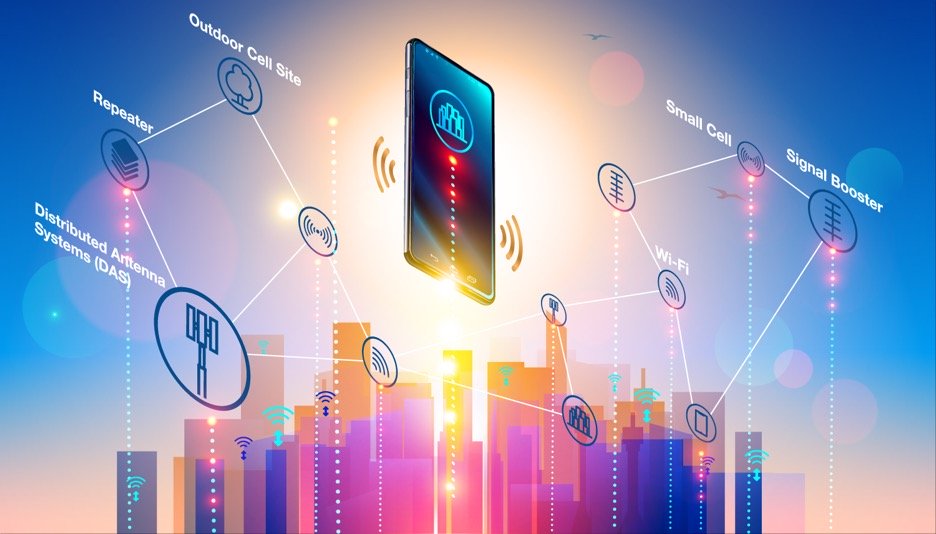In-Building Wireless Coverage Solutions

First in a 3-part series
Today, everyone expects fast, reliable wireless service both indoors and outdoors, whether it’s for personal use, business applications, or to meet the needs of first responders and public safety personnel.
Looking to the future, an array of new mobile devices – like 5G-capable smartphones, wearables, and Internet of Things (IoT) smart devices – will also require connectivity and increase expectations for quality wireless service everywhere.
For building owners and managers, addressing this soaring demand for wireless capacity requires prompt, smart decisions. Every in-building environment is different, with its own set of challenges. As competing solutions vie for attention, it can be hard to know which one is best for your property.
Wireless Terminology
To help you get started, SOLiD offers this primer to understand standard industry terms and wireless connectivity solutions.
Outdoor Cell Site
Every mobile carrier – Verizon, AT&T, T-Mobile, Sprint, etc. – builds outdoor cell sites, typically referred to as “macrocells,” to provide cellular coverage for their subscribers. These sites include antennas, a base station receiver, transmitters, GPS, and backup power.
The equipment reliably transmits signals to and from mobile devices in the area. Antennas can be attached to a cell tower placed on a rooftop.
The typical coverage area for a macrocell is up to three miles. Often, multiple carriers and public safety agencies will share a macrocell site to serve their subscribers and support emergency services in the coverage area.
In dense urban areas, cellular equipment can also be placed on utility poles or other types of street furniture to provide service to high demand areas. The coverage range of these installations may be as small as a few hundred feet.
Often, the macrocells in a given area cannot provide adequate coverage for all of the connected devices. Plus, natural barriers – like hills and trees – or manufactured substances – such as concrete and glass – can block signals and degrade coverage, especially inside buildings. In these cases, several technologies can fill in coverage gaps. These include distributed antenna systems, repeaters, and small cells.
Distributed Antenna Systems
Distributed Antenna Systems (DAS) operate both indoors and outdoors. DAS deployments began in the late 1980s. Today they are often found in large office buildings, hospitals, hotels, universities, airports, stadiums, and underground transit systems.
DAS solutions serve two essential purposes. First, they deliver cellular service indoors where signals from macrocells are weak or nonexistent. Second, they provide dedicated capacity in a building rather than sharing it with all of the subscribers covered by a cell tower. Each DAS is scaled to meet building occupancy and bandwidth demands.
A DAS features strategically-placed antennas throughout an indoor venue to expand and enhance wireless connectivity. The antennas connect to DAS remotes. Each remote connects via fiber optic cabling to a centralized headend. The headend aggregates and distributes signals between the service providers’ base stations and the DAS.
Signal Booster/Repeater
A cellular signal booster uses an antenna placed outside the building and an amplifier connected to indoor antennas to rebroadcast the mobile network inside the building.
Signal boosters have limitations. For example, they cannot sufficiently amplify weak signals and are typically used only for smaller coverage areas. Signal boosters are less common due to potential interference and capacity planning issues, and they can only improve signal levels but cannot increase capacity.
Small Cell
As the name implies, small cells are downsized versions of larger macrocell base stations. Their small size allows mobile carriers to install them in places closer to the end-user to improve signal reception and capacity. Small cells provide a smaller coverage area versus traditional macrocells, but they deliver signals to areas the macrocells can’t reach economically.
A small cell effectively addresses the needs of a modest number of individuals using a single carrier in a small space. By contrast, a DAS is a multi-carrier solution, potentially serving a large number of users throughout a large building or campus environment.
Wi-Fi
Wi-Fi provides a wireless data connection delivered via a router to the internet. Users remain connected as long as they move about within the wireless local area network. By contrast, a cellular network service – delivered by DAS, small cells, or repeaters – offers direct internet access and voice communications without a router throughout the mobile network.
Wi-Fi is a suitable low-cost solution to provide wireless internet access for many applications, but it is not a substitute for cellular mobility. Cellular networks also offer more capacity and superior security.
What is the Best Solution for your In-Building Connectivity Needs?
The best solution for your needs should be considered from a few different dimensions and discussed with a reputable solution provider. You will need to determine: is the site experiencing capacity or coverage deficiencies? Is the bandwidth demand static or dynamic? Is there a requirement to provide service for many or all of the wireless service providers? And what is the available budget?
SOLiD: Your Trusted Advisor
We hope you have come away with a basic understanding of the different solutions available today. Picking the right option for your particular needs will be further explored in the next blog post on this topic.
In a sea of seemingly endless wireless options, it is essential to zero in on what’s best for your organization both today and tomorrow. Trust SOLiD to help you better understand your options.
SOLiD has already delivered many thousands of DAS remotes around the world. Our DAS solutions consistently deliver the best price/power ratio. As you sort through your wireless options, count on SOLiD to be the voice of clarity.
Connect with us to learn more about solving your connectivity issues.